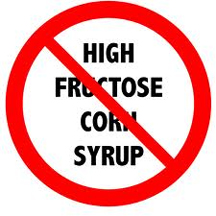More Reasons to Avoid
High Fructose Corn Syrup
By Alice Osborne
 I am SO passionate about helping us (and especially our children) return to good health and avoid obesity that I just have to send up yet another “red alert” regarding high fructose corn syrup. We just keep getting bigger and bigger and this sneaky ingredient is at the heart of this treand. Read on for what I found on one of my favorite websites, Care2. This information is from Samantha:
I am SO passionate about helping us (and especially our children) return to good health and avoid obesity that I just have to send up yet another “red alert” regarding high fructose corn syrup. We just keep getting bigger and bigger and this sneaky ingredient is at the heart of this treand. Read on for what I found on one of my favorite websites, Care2. This information is from Samantha:
“By now, you’ve more than likely seen one of the ads put out by the Corn Refiners Association. The ads tell the story of a “natural” sweetener made from corn. They go on to insinuate that high fructose corn syrup has been unfairly portrayed and that this truly American ingredient is fine in moderation. This ad was part of a massive $30 million ad campaign last year. The campaign claimed that high fructose corn syrup has the “same natural sweeteners as table sugar and honey.” Since then, the association has released a number of ads with the same message.
“But when push comes to shove, what are the facts about high fructose corn syrup? How is it made? Is it healthy in moderation to the body and the planet? Here are the facts, so that the next time you’re asked, you can confidently dispel any high fructose corn syrup rumors.
 1. The Process of Making High Fructose Corn Syrup is Weird
1. The Process of Making High Fructose Corn Syrup is Weird
“First of all, there’s nothing natural about high fructose corn syrup and it most certainly does not exist in nature. The process starts off with corn kernels, yes, but then that corn is spun at a high velocity and combined with three other enzymes: alpha-amylase, glucoamylase, and xylose isomerase, so that it forms a thick syrup that’s way sweeter than sugar and super cheap to produce. That’s why it’s poured into a huge majority of mass produced processed foods.
 2. High Fructose Corn Syrup Does Weird Stuff to Your Body
2. High Fructose Corn Syrup Does Weird Stuff to Your Body
“While the commercials claim that it’s fine in moderation, the truth is that the whole problem with high fructose corn syrup in the first place, is that moderation is seemingly impossible. The syrup interferes with the body’s metabolism so that a person can’t stop eating. It’s truly hard to control cravings because high fructose corn syrup slows down the secretion of leptin in the body. Leptin is a crucial hormone in the body that tells you that you’re full and to stop eating. That’s why it’s so closely associated with obesity in this country. It’s like an addictive drug.
3. There Might be Mercury in Your Corn Syrup
“And what about the rumors of mercury being found in corn syrup? I wrote last year that according to MSNBC in one study, published in the Journal of Environmental Health, former Food and Drug Administration scientist Renee Dufault and colleagues tested 20 samples of high fructose corn syrup and found detectable mercury in nine of the 20 samples.
“ ‘We went and looked at supermarket samples where high fructose corn syrup was the first or second ingredient on the label,’ Dr. David Wallinga, a food safety researcher and activist at the nonprofit Institute for Agriculture and Trade Policy said. These 55 different foods included barbecue sauce, jam, yogurt, and chocolate syrup. ‘We found about one out of three had mercury above the detection limit,’ Wallinga said.
 4. The Environmental Impact of High Fructose Corn Syrup is HUGE
4. The Environmental Impact of High Fructose Corn Syrup is HUGE
“Most corn is grown as a monoculture, meaning that the land is used solely for corn, not rotated among crops. Large monocultures, which are usually genetically modified, can be riddled with pests. As a result, monocultures are often dressed with a toxic cocktail of pesticides so that they can survive. Monocultures can deplete the nutrients in soil and lead to erosion. In addition, the pesticides used to grow them pollute our soil and ground water.
 Our Advice: Skip the High Fructose Corn Syrup
Our Advice: Skip the High Fructose Corn Syrup
“Luckily, we have a lot more options when it comes to avoiding this frightening ingredient. The Corn Refiners Association wouldn’t spend $30 million on advertisements if they didn’t feel threatened and that’s because more and more alternatives are becoming available. Read labels on every processed food that you buy. Stores like Whole Foods and Earth Fare carry tons of foods without it.
Make Your Own Snack Foods
“Also consider making your own snack foods instead of buying the prepackaged variety. This way you can control your ingredients and use safer sweeteners. You can also save some major dough and reduce the amount of packaging that your family throws away.”
If you’re convinced, here is a great starter recipe for making our own snack foods—healthy baked veggie chips!
Baked Veggie Chips
Serves 8 – 10
 6 or more vegetables of your choice, thinly sliced
6 or more vegetables of your choice, thinly sliced
Salt for liquid extract and to taste
Vegetable oil
Salt vegetables on paper towels for 20 to 30 minutes to dry out (as described above) then rinse under cold water and dry well. Meanwhile, heat oven to 275 degrees F. Lay vegetables on a baking sheet rubbed with oil. Drizzle vegetable slices with oil. Bake 40 to 50 minutes, flipping if needed. Place cooked chips on paper towels to cool and season lightly with salt.

Contribute to the Cook'n Club!
DVO would love to publish your article, prose, photography and art as well as your cooking, kitchen and nutrition tips, tricks and secrets. Visit the Newsletter Submission / Win Win for All section in our Forum for more information and details.

